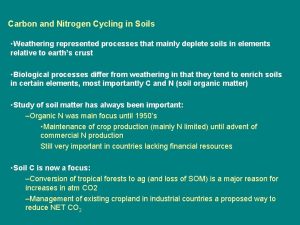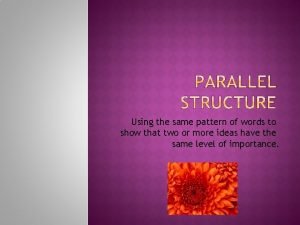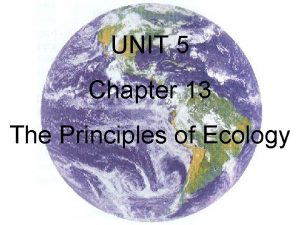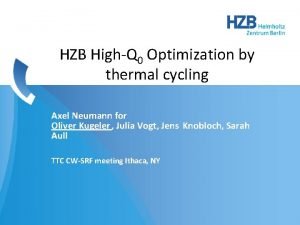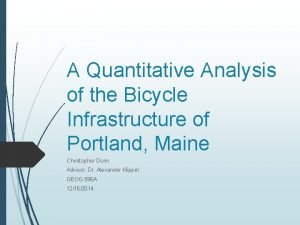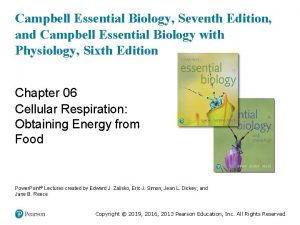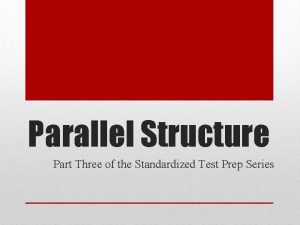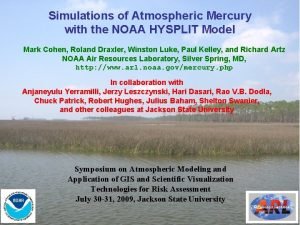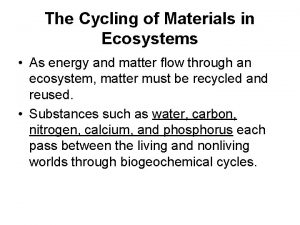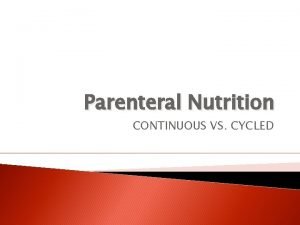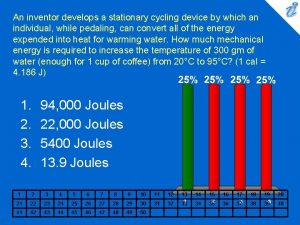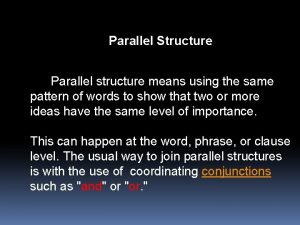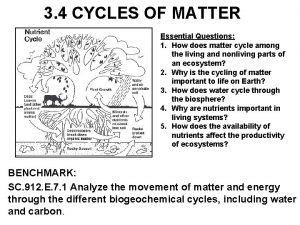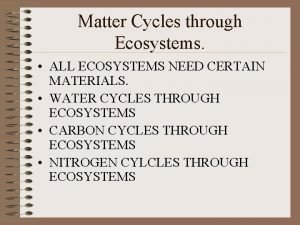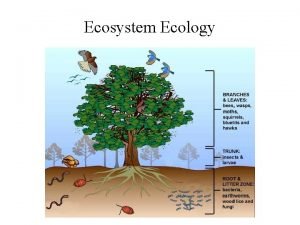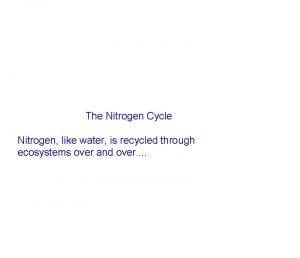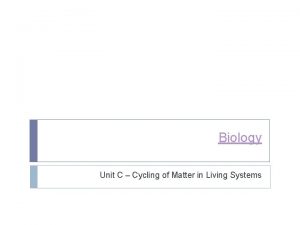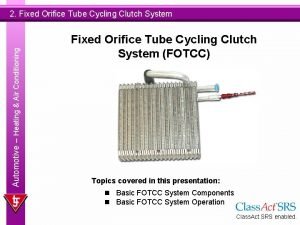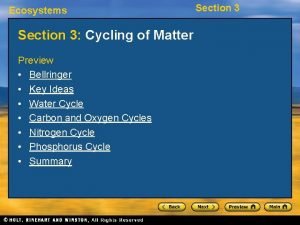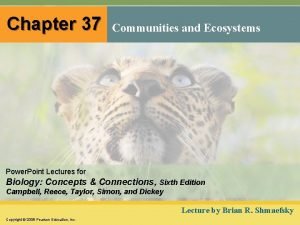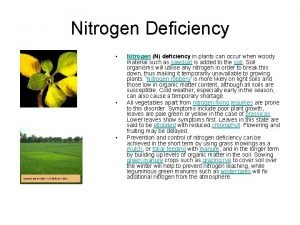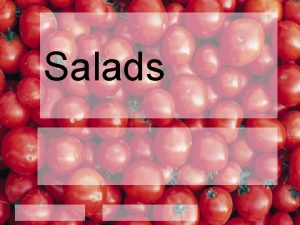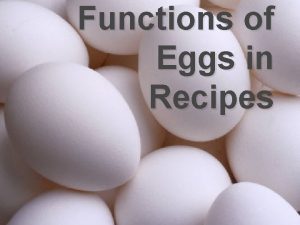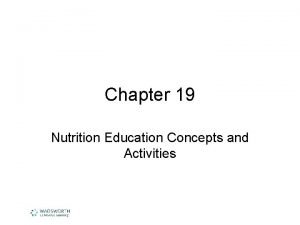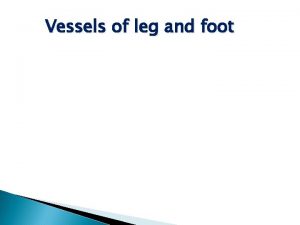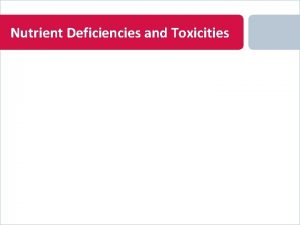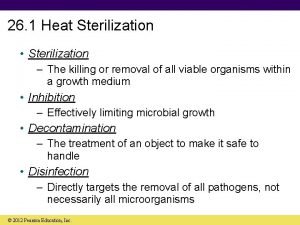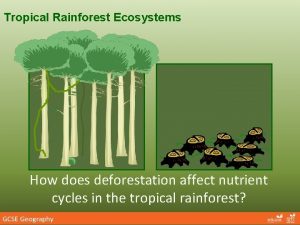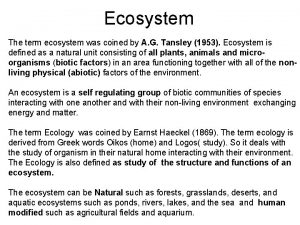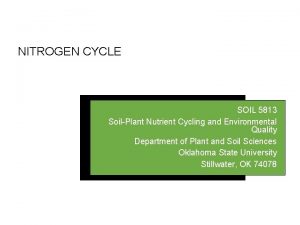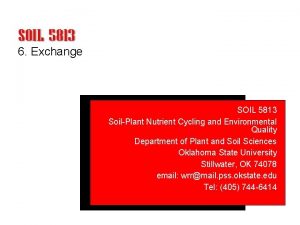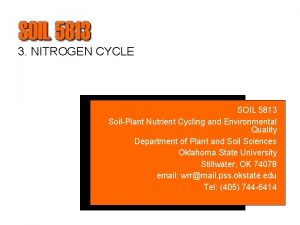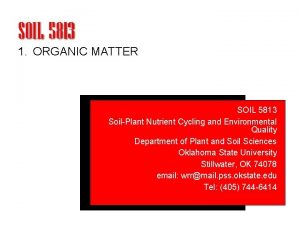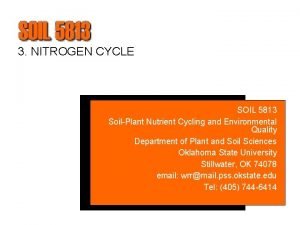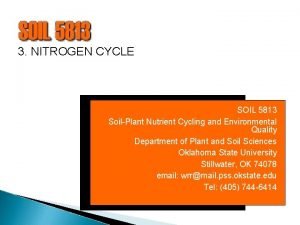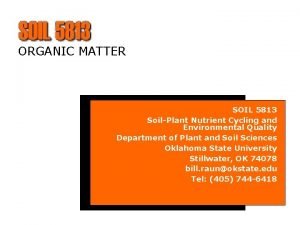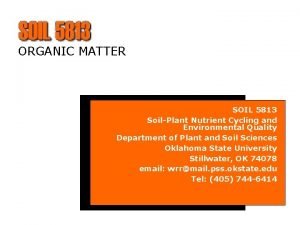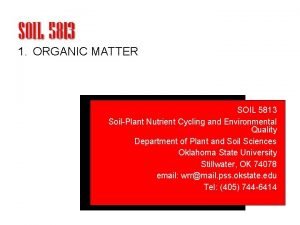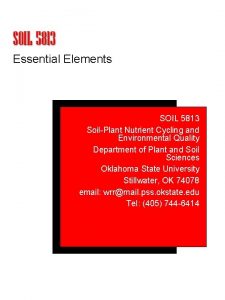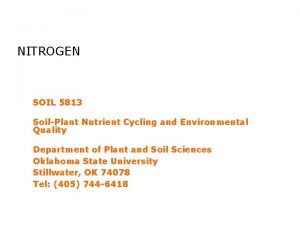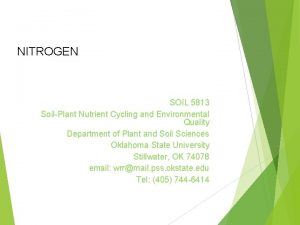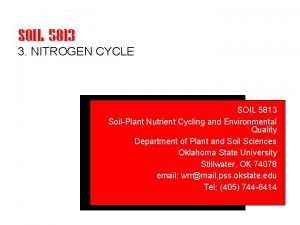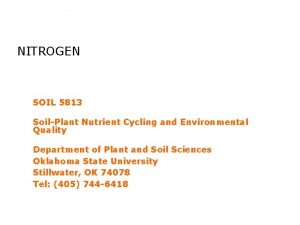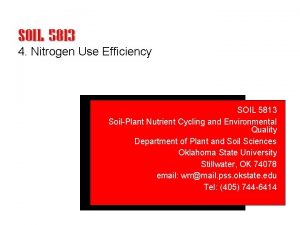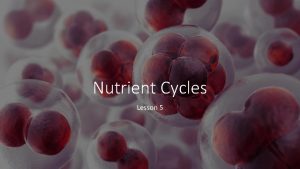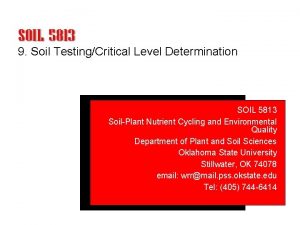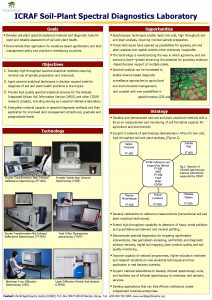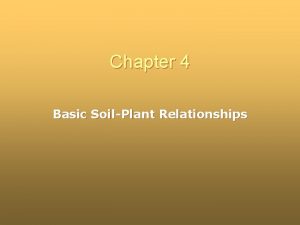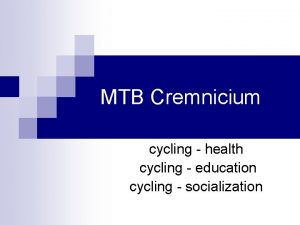7 Soil Testing SOIL 5813 SoilPlant Nutrient Cycling


















































- Slides: 50

7. Soil Testing SOIL 5813 Soil-Plant Nutrient Cycling and Environmental Quality Department of Plant and Soil Sciences Oklahoma State University Stillwater, OK 74078 email: wrr@mail. pss. okstate. edu Tel: (405) 744 -6414

• Assess the relative adequacy of available nutrients (or lime requirements) • To provide guidance on amounts of fertilizers (or lime) required to obtain optimum growth conditions for plants (Mc. Lean, 1977) • Diagnose nutrient limitations before a crop is planted so that corrective measures can be taken. *Must be fast, reliable and reproducible

Philosophical Use/Interpretation of Soil Testing 1. Base Cation Saturation Ratio 2. Nutrient Maintenance Disregarding the soil test level, a quantity of nutrient should be added to replace the amount expected to be removed by the crop. All required nutrients - not feasible. 3. Nutrient Sufficiency No yield response to nutrients above a certain soil test level a. response assured very low b. response likely low c. response possible medium d. response unlikely high

Continuing Problems in Soil Testing Depth of Sampling 1. 0 -6, 0 -8, 0 -12, inclusion of subsoil (micronutrients) Critical Levels 1. Cate Nelson 2. Mitscherlich 3. Quadratic 4. Square Root 5. Linear-plateau 6. Quadratic-plateau

Economic and Agronomic Impacts of Varied Philosophies of Soil Testing (Olson et al. , 1982) Field experiments (1973 -1980) 5 locations Irrigated Corn (Zea mays L. ) 5 soil testing laboratories Lab E (University of Nebraska) No differences in yield No agronomic basis for ‘base-cation-saturation-ratio‘ or 'maintenance' concepts Maintenance: whatever the soil test level, a quantity of nutrient should be added to replace the amount expected to be removed by the crop. K, S, Zn, Mn, Cu, B, Mg, Fe This experiment tests other issues: Private versus Public Sector Research Need for Watchdog Agencies Value of Long-Term Research Need for subsoil data

University of Minnesota Kansas State University “I think it is awfully important that dealers and producers use the lab that bases its recommendations on research from the state in which the dealers operate. ” George Rehm, Univ. of Minnesota “Part of the problem with university soil testing programs is that they are not cost competitive with commercial labs…. University labs typically undercut the commercial operations” Randy Hemb, Minnesota Valley Testing Lab Fertilizer “Dealers have an obligation to provide a fertilizer recommendation that will keep that farmer in business. If the farmer goes out of business, the dealer goes out of business, and 99 percent of the dealers today recognize that. ” George Rehm, Univ. of Minnesota

Soil Testing for Different Nutrients Total Nitrogen in Soils: Surface soils: 0. 05 to 0. 10% precision 0. 01% = +/- 200 lb/ac Why would we run total N on soils if the precision is so low? · long term experiments (differences greater than 200 lb N/ac) · C: N relationships at the same level of precision

A. Kjeldahl 1883 (organic + inorganic N) -digestion to convert organic N to NH 4 -determination of NH 4 in the digest (N pool consists of NO 3 -, NH 4+, NO 2 -, organic N) devardas: reducing agent, that is a finely powdered mixture of metals that act as a source of donor electrons to reduce NO 3 - and NO 2 - to ammonium devardas N pool + K 2 SO 4, Cu. SO 4, Se, H 2 SO 4 -----> (NH 4)2 SO 4 Digest (NH 4)2 SO 4 + Na. OH ----> NH 3 + Na. SO 4 (catch in boric acid) titrate K 2 SO 4 is used to raise the temperature of the digest (increases speed and completeness of the conversion of organic N to NH 4) Se, Cu are used as catalysts to promote the oxidation of the organic matter

NO 3 and NO 2 are not included in the total N analysis from dry combustion, but it does not matter since there will be less than 20 lb N /ac as NO 3 and the total N procedure detects to only +/- 200 lbs N/ac e. g. 0. 01 +/- 200 lbs/ac 20 lbs N/ac as NO 3 is lost between 0. 01 and 0. 02 %total N 0. 02 +/- 400 lbs/ac because its small value exceeded the detection limits. On a KCl extract: (have both NH 4 and NO 3 in the extract) -distill over once (to collect NH 4) -add devardas alloy (distill over again to collect NO 3 and NO 2) devardas alloy: acts as a source of donor electrons to reduce NO 2 and NO 3 to NH 4 -problems: N-N and N-O compounds

Dry Combustion (Dumas 1831) -Sample heated with Cu. O at high temp (above 600 °C) in a stream of CO 2 -Gasses lost are passed over hot Cu to reduce nitrogen to N 2 (NO and NO 2 (brown gas) or NOx to N 2 -Next over Cu. O to convert CO to CO 2. (Cu. O is giving up O, completing the oxidiation of CO to CO 2) -N 2 -CO 2 mixture is collected in a nitrometer containing concentrated alkali which absorbs CO 2 and the volume of N 2 gas is measured. 2 NH 4 Cl + 4 Cu. O -----> N 2 + 4 H 2 O + 2 Cu. Cl + 2 Cu (CO 2) problems: heterocyclic compounds (pyridine) are difficult to burn NA-1500 Sample weighed in a tin (Sn) container Combustion reactor enriched with pure oxygen (sample oxidation) 1020 °C in combustion tube Reaches 1700 °C during flash combustion (complete oxidation) Flash combustion converts all organic and inorganic substances into elemental gases (stable compounds combusted) Combustion products carried by He pass through an oxidation catalyst of chromium oxide

Combustion Reactor Reduction Reactor CO + 1/2 O 2 = CO 2 (Cr 2 O 3 is accepting electrons) Cr 2 O 3 ensures complete combustion (oxidation) of all organic materials NOx N 2 (Cu is donating electrons) Combustion products (CO, N, NO) and water pass through a reduction reactor (metallic Cu) Excess O 2 is removed in the reduction reactor (Cu at 650 C) N oxides from the combustion tube are reduced to elemental N 2 Taking CO, N, NOx and converting them to CO 2, N 2 Gases are separated in a chromatographic column and detected using a thermal conductivity detector (TCD) which gives an output signal proportional to the concentration of the CO 2 and N 2 present

Capillary column (up to 50 m) Non-polar polymer (Si-CH 3 and/or Ph) (glue) N 2 CO 2 Hot wire He TC Thermal conductivity detector Time

Inorganic Nitrogen NO 3 -N Inorganic N may represent only a small fraction < 2% of the total N in soils (Bremner, 1965) Nitrate testing does not work in Illinois. Why? high OM high mineralization potential consideration of NH 4 R-NH 2 groups from N cycle ·rapid changes (biological transformations) affect inorganic N analysis

NO 3 -N and NO 2 -N 1. Phenoldisulfonic acid or chromotrophic acid interference of organic matter, Cl and Fe have affected these colorimetric procedures 2. Selective ion electrodes interference of Cl (NH 4)2 SO 4, Ag. SO 4 extracting solution: Ag used to precipitate Cl 3. Cadmium reduction 2 M KCl extract (colorimetric procedure) - samples are stable for several months if stored at low temperatures not subject to interference, extremely sensitive making dilution possible. NO 3 reduced to NO 2 by passing through a column of copperized Cd NO 2 reacts well with the diazotizing reagent (sulfanilamide) and NO 3 does not, thus explaining the need for reducing NO 3 to NO 2 for analysis using the Griess-Ilosvay method 4. Steam distillation with Devardas alloy (reductant) reduce NO 2 and NO 3 to NH 4

NH 4 -N Bremner (1959) Soils contain a large amount of fixed (non-exchangeable NH 4). Defined as the NH 4 that cannot be replaced by a neutral K salt solution present as NH 4 ions in interlayer positions of 2: 1 type clay minerals Air drying can lead to small but significant changes in NH 4 -N -Steam distillation with Mg. O (alkaline reagent) color: indophenol blue -2 M KCl (indophenol blue) phenol and NH 3 react to form an intense blue color -Ammonia gas sensing electrodes Problems in N analysis: -accuracy is measured by the least precise measurement. -weight of the soil is the largest error (propagates through to +/- 0. 01%N 0. 01% N = +/- 100 ppm (0. 01* 10000) total N in soils 0. 10 = 1000 ppm +/- 100 ppm inorganic N in soils 0. 002 = 20 ppm +/- 1 ppm Total N 1000 ppm Inorganic N 20 ppm Organic N? 980 ppm -Inorganic N not determined on percent basis, done on an aliquot basis -Cannot subtract 20 from 1000 to get organic N (determined on a different basis) -Unrealistic because of the incompatibility of error terms -Organic-N is difficult to determine (by subtraction, we have an extremely poor estimate)

Organic N Procedures exist, but are unreliable and are not reproducible Mineralizable N 1. Leach with Ca. Cl 2 - dissolves all the soluble N (NO 3 and NO 2) 2. Incubate the soil - over time - to determine the amount of NO 3 that has been mineralized (set period of time under set conditions) 3. Leach with Ca. Cl 2 again (sample now has NO 3) 4. Determine concentration

Phosphorus Soil Index Procedures Bray and Kurtz P-1 0. 025 N HCl and 0. 03 N NH 4 F (p. H = 3. 15) Removes easily acid soluble forms of P, (Ca-P & Fe, Al-P) NH 4 F dissolves Al and Fe-P by its complex ion formation with these metal ions in acid solution. This method has proved to be very successful in acid soils. In view of the high efficiency of the fluoride ion in dissolving phosphate, Bray (1945) recommended the use of this reagent together with HCl as an extractant (effectively removed sorbed phosphate) Al reacts with F and inactivates Al leaving P in solution. Use of NH 4 F will increase extractable P, or stabilize P (restricting Al from precipitating with P because of the solubility constants)

Mehlich II 0. 20 NH 4 Cl, 0. 2 N CH 3 COOH, 0. 015 N NH 4 F and 0. 012 N HCl (p. H = 2. 5) The concentrations of HCl and NH 4 F used in Mehlich are half that used in Bray and Kurtz P-1. However this extracting solution also contains NH 4 Cl and acetic acid which probably buffer the solution (i. e. , keeps its acidic strength for a longer period of time). Therefore, it can dissolve more of the P in apatite. Mehlich III (more acid than Bray) short shaking time (filtering time is problematic) 11%CCE will neutralize Mehlich – making the extracting solution water 0. 2 N CH 3 COOH, 0. 015 N NH 4 F, 0. 25 N NH 4 NO 3, 0. 13 N HNO 3, 0. 001 M EDTA (p. H = 2. 4) Designed to be applicable across a wide range of soil properties ranging in reaction from acid to basic. Can also be used for exchangeable cations (Ca and Mg). Because this extractant is so acid, there is some concern that the soil can be dissolved, increasing exchangeable amounts.

Olsen 0. 5 N Na. HCO 3 (p. H = 8. 5) This extracting solution is used to extract phosphorus in calcareous soils. It will theoretically extract the phosphorus available to plants in high p. H soils. This extractant decreases the concentration of Ca in solution by causing precipitation of Ca as Ca. CO 3; as a result, the concentration of P in solution increases. Ca. HPO 4 = Ca+2 + HPO 4= HCO 3 Ca. CO 3 Essentially, increase the activity of CO 3 in solution which reacts with Ca, and Ca. CO 3 precipitates. Nelson et al. (1953) (Mehlich I and or "Double Acid") 0. 05 N HCl and 0. 025 N H 2 SO 4 (p. H<2. 0) Found to be effective in high P-fixing soils of North Carolina. H 2 SO 4 was found to be more effective than HCl in dissolving Fe phosphates but that both were equal regarding Al phosphates.

Extractable P discussion: The p. H of the extracting solution is an indicator of what forms of P will be extracted. However, this should be used with caution as the shaking time is important in terms of reaching an equilibrium. Susuki et al. (1963) noted that 0. 1 N HCl extractable P was positively correlated with Ca-P. Na. HCO 3 was negatively correlated with Ca-P on 17 Michigan soils (p. H 4. 87. 8) What would happen if Bray P-1 was used on a calcareous soil? The lime in the calcareous soil would neutralize the acidity in the extracting solution thus decreasing its ability to extract the Fe and Al-P forms which would be available at that soils p. H.

Calibrations for the Bray-Kurtz P-1, Mehlich III and Olsen soil tests (Tisdale, Nelson, Beaton and Havlin, 1993) ______________________________________ P sufficiency level Bray-Kurtz P-1 Mehlich III Olsen Fertilizer P Recommendation ______________________________________ lb P 2 O 5/ac kg P/ha Very low <5 <7 <3 50 25 Low 6 -12 8 -14 4 -7 30 15 Medium 13 -25 15 -28 8 -11 15 8 High >25 >28 >12 0 0 ______________________________________

Total P ? Analysis for total P in soils abandoned in the early 1900's Scientists recognized that total P was not correlated with plant availability. Various strengths of extracting solutions were evaluated for specific soils at selected soil p. H that mirrored what the plant would find in soil solution. All of these are indices that determine orthophosphate concentrations (from the dissolution of precipitated forms). Attempts to correlate extractable P (x - procedure) with total P will result in meaningless information. Total P (strong acid digest) will in essence dissolve P forms that will not be available at that soils specific p. H.

Nutrient Interactions Bray and Nye: K applications on soils with high K by mass action displace Al+++ which complexes with P inducing a net P deficiency (p. H < 6. 0) P and Zinc deficiencies attributed to the immobilization of zinc owing to the increase in the concentrations of P in the roots above threshold values. Depression of zinc concentrations in plant tissue by P occurred in the plant and not in the soil). (interaction

Source of N by P NO 3 - uptake (increase p. H) NH 4+ uptake (decrease p. H)

Spectroscopy Light is considered to be a stream of particles. The discrete particles or units of energy are called photons or quanta. A photon of blue light contains much more energy than a photon of red light. Interaction of light with matter 1 nm = 1 mu (millimicron) = 10 A (angstrom) = 10 -7 cm The interaction of radiation with matter may result in the absorption of incident radiation, emission of fluorescence or phosphorescence, scattering into new directions, rotation of the plane of polarization, or other changes. Each of these interactions can provide useful information about the nature of the same in which they occur (Tinoco et al. 1978). Color is characteristic of the spectrum (in the visible region) of light transmitted by the substance when white light (or sunlight) shines through it, or when light is reflected from it.

<0. 01 Gamma (non particulate photons) 0. 01 -10 X-Ray (photons) 10 -380 Ultraviolet Wavelength absorbed, nm Absorbed Color Transmitted Color (Complement) 380 -450 Violet Yellow-green 450 -495 Blue Yellow 495 -570 Green Violet 570 -590 Yellow Blue 590 -620 Orange Green-blue 620 -750 Red Blue-green ________________________________ 750 -1 x 106 Infrared 1 x 106 -1 x 1011 Micro and short radio waves >1 x 1011 Radio, FM TV ________________________________

Wavelength: distance of one complete cycle Frequency: the number of cycles passing a fixed point per unit time l = c/v l = wavelength in cm v = frequency in sec-1 or hertz (Hz) c = velocity of light in a vacuum (3 x 1010 cm/sec) Electromagnetic radiation possesses a certain amount of energy. The energy of a unit of radiation, called the photon is related to the frequency by E = hv = hc/l where E is the energy of the photon in ergs h is Planck’s constant 6. 62 x 10 -27 erg-sec The shorter the wavelength or the greater the frequency, the greater the energy. Energy of a single photon (E) is proportional to its frequency (v) or inversely proportional to its wavelength.

If a molecule absorbs radiation, it is raised to a higher energy level, with the increase in energy being equal to the energy of the absorbed radiation (hl). The relative energy levels of the three transition processes are in the order electronic > vibrational > rotational If the electromagnetic force results in a change in the arrangement of the electrons in a molecule, we say that a transition to a new electronic state has occurred. The absorbed photon results in the excitation of the molecule from its normal or ground state, G, to a higher energy or excited electronic state, E. The excited electronic state has a rearranged electron distribution. When considering absorbing substances that are either liquids, solids or gases, each will have a characteristic transmission of light. Suppose that light of intensity Io is incident from the left, propagates along the x direction and exits from the right with decreased intensity It. At any point x within the sample, it has intensity I, which will decrease smoothly from left to right.

If the sample is homogeneous, the fractional decrease in the light intensity is the same across a small interval dx, regardless of the value of x. The decrease for a solution depends linearly on the concentration of the absorbing substance. Not all molecules can absorb in the infrared region The wavelength of absorption is a measure of the energy required for the transition Each molecule will have a complete absorption spectrum unique to that molecule, so a 'fingerprint' of the molecule is obtained

Absorption of Visible Light by Photopigments Absorption Sunlight reaching earth SPAD 501, 502 (430, 750) Phycoerythrin Chlorophyll b Phycocyanin B-Carotene Chlorophyll a 300 400 500 600 700 Wavelength, nm 800 Lehninger, Nelson and Co

Short wavelength High energy Long wavelength Low energy Phycoerythrin Chlorophyll b Phycocyanin B-Carotene 0. 01 10 Infrared Ultraviolet X-Rays Chlorophyll a 380 450 495 570 590 620 wavelength, nm 750

White Light Interference Filter Photodiode Phycocyanin Chlorophyll b B-Carotene Phycoerythrin 380 450 495 570 590 620 wavelength, nm Chlorophyll a 750

Near-Infrared Absorption Major Amino and Methyl Analytical Bands and Peak Positions CH 3 RNH 2 CH 3 RNH 2 | | | | 700 800 900 1000 1100 1200 1300 1400 RNH 2 | | 1500 1600 Wavelength, nm | | | 1700 1800 1900 2000 2100 2200

In-Season NDVI at F 5 = Estimated Yield (INSEY)2 days from planting to F 5, GDD>0 +Good predictor of final grain yield +Requires only one sensor reading +Appears to work over different regions Units: N uptake, kg ha-1 day-1 where GDD>0

Winter Wheat 24 locations in Oklahoma 1998 -2001 Soft White Winter Wheat 7 locations in Virginia, 2001 Spring Wheat 4 locations in Ciudad Obregon, MX 2001

Resolution of Soil Fertility Variables Organic Matter Range: 1. 6 -3. 5

Mean surface soil test P and fertilizer P recommendations, bemudagrass pasture, Burneyville, OK 30 Mehlich III P Fertilizer 60 25 50 20 40 15 30 10 20 10 5 0 0 22 0 2 4 6 8 10 12 14 DISTANCE, m 16 18 20 P FERTILIZER, kg/ha MEHLICH III P, mg/kg 70

160 acre field ($10/soil sample) Sensor Based 9 ft 2 $7, 744, 000 Map Based $77, 440 100 900 ft 2 x 4840 48. 4 Grid Based $1600 1 Acre 43560 ft 2

Soil Testing versus Non-destructive Sensor Based VRT Soil Testing Sensor Based VRT low resolution high resolution Chemistry-Site specific Reliable and tested untested Years of correlation/calibration new technology Economical high potential of being economical Crop specific untested Variety specific untested Management specific untested row spacing/tillage Nutrient interactions untested NA weed recognition NA time of day NA shadow/clouds NA direction of travel



Prediction of YIELD POTENTIAL

Experimental Design/Soil Testing and Field Variability Replication gradients: Do slopes (up and down or side to side) in fields adequately represent which direction a particular nutrient will increase or decrease? Are Blocks actually needed? Number of Replications: If plot size remains large and greater than the field element size, increasing the number of replications will unlikely lead to increased power for detecting differences between treatments Plot Size: Because field variability has been demonstrated to be somewhere around 9 square feet, field experiments as we now know them must change. Common plot sizes are between 250 to 1000 square feet. Plant breeders have generally employed much smaller plot sizes and because of this, CV's from their work are generally smaller than that found in fertility/weed type trials.

50 m 30 m

60 feet 150 feet

Cate and Nelson (1965) % yield versus soil test level Two Groups: 1. probability of response to added fertilizer is small 2. probability of response to added fertilizer is large A. Percent yield values obtained for a wide range in locations (fertilizer rate studies) Percent yield = yield at 0 level of a nutrient / yield where all factors are adequate B. Soil test values obtained (Check Plot) Will generate a single % yield and one soil test value for each location C. Scatter diagram, % yield (Y axis) versus soil test level (x axis) Range in Y = 0 to 100% D. Overlay -overlay moved to the point where data in the +/+ quadrants are at a maximum -point where vertical line crosses the x = critical soil test level


Critcal level depends on the extraction method used and crop being grown. Cate-Nelson: Maximizes the computed chi-square value representing the test of the null hypothesis that the # of observations in each of the four cells (quadrants is equal). 2. Mitscherlich 3. Quadratic 4. Square Root 5. Linear Plateau: obtaining the smallest pooled residuals over two linear regressions. Equation MR MER (dy/dx = PR) ________________________________________ 2. Mitscherlich Log(A-Y) = Log A - C 1(x+b) x=log((2. 3*A*c)/PR)/c-b 3. Quadratic y = b 0 + b 1(x) - b 2(x 2) x=0. 5 b 1/b 2 x=(PR-b 1)/(2*b 2) 4. Square Root y = bo + b 1(x) + b 2(sqrt(x)) x=0. 25(b 2/b 1)2 x=(b 2/ 2*(PR-b 1))2 5. Linear Plateau y = bo + b 1(x) when x < joint y = bo + b 1(joint) when x > joint ________________________________________

Use of Price Ratios PR = (price per unit fertilizer) / (price per unit yield) Optimum rate of fertilizer capable of generating the maximum economic yield is dependent upon the price of fertilizer, the value of the crop and magnitude of fixed production costs. The value of a crop defined as a function of yield and rate of fertilizer can be expressed as: V = Y * Py = F(x) * Py where yield (Y) for each fertilizer rate is multiplied by the crop price (Py) per unit of yield. A line describing fertilizer costs per unit area cultivated can be expressed as a function of fixed costs (F) and fertilizer price (Px) times the amount of fertilizer (X) T = F + Px * X where total cost (T) is a linear function of fertilizer amount, the slope of the line is given by the price of fertilizer and the intercept by the amount of fixed costs involved (F).

A plot of the value and cost functions illustrates the areas where use of fertilizer is profitable. Net profit can only be generated by use of a fertilizer amount equal or greater than 0 -x 1. Fertilizer should not be used if the value curve is lower throughout than the total cost curve for fertilizer plus fixed costs (F). With fixed costs involved, the amount of fertilizer that can be used profitably is greater than zero or an amount equal to or greater than 0 -x 1. For fertilizer input greater than 0 -x 1, crop value exceeds costs and net profit is generated. Profit from fertilizer application can be increased until input reaches the value of 0 -x 2. This is the level which maximizes profit. At 0 -x 2 the difference between value and cost is at a maximum. For each production function the amount of fertilizer which maximizes profit can be found by obtaining the first derivative and setting it equal to the price ratio (PR). PR = Price per unit of fertilizer / Price per unit of yield (from Barreto and Westerman, 1985)
 Salmonella transport media
Salmonella transport media Carbon and nitrogen cycling in soil:
Carbon and nitrogen cycling in soil: Same pattern words
Same pattern words Cycling event sponsorship proposal
Cycling event sponsorship proposal Wendy badger cycling
Wendy badger cycling Hasselt tourism
Hasselt tourism A bird stalks kills then eats
A bird stalks kills then eats Energy flow and material cycling in ecosystem
Energy flow and material cycling in ecosystem Rsurf
Rsurf Quantitative research about cycling
Quantitative research about cycling Consumer
Consumer Chapter 2 principles of ecology answer key
Chapter 2 principles of ecology answer key In 1896 arbiters of fashion a specific costume for cycling
In 1896 arbiters of fashion a specific costume for cycling Road cycling 101
Road cycling 101 Choose the sentence that demonstrates parallel structure.
Choose the sentence that demonstrates parallel structure. Guide to cycling
Guide to cycling Cycling swanier
Cycling swanier Principles of ecology section 3 cycling of matter
Principles of ecology section 3 cycling of matter Transpiration moves water from
Transpiration moves water from Tpn tapering guidelines
Tpn tapering guidelines An inventor develops a stationary cycling device
An inventor develops a stationary cycling device Castleknock cycling club
Castleknock cycling club Buying and disposing consumer behavior
Buying and disposing consumer behavior Mary likes hiking swimming and cycling
Mary likes hiking swimming and cycling Cycling to work
Cycling to work Precipitation in the water cycle
Precipitation in the water cycle Matter cycling in ecosystems
Matter cycling in ecosystems Cycling seniors
Cycling seniors Energy flow and material cycling in ecosystem
Energy flow and material cycling in ecosystem How does carbon enter the atmosphere
How does carbon enter the atmosphere Cycling of matter definition biology
Cycling of matter definition biology Pan-european master plan for cycling promotion
Pan-european master plan for cycling promotion Fixed orifice tube ac system
Fixed orifice tube ac system Section 3 cycling of matter answer key
Section 3 cycling of matter answer key Chemical cycling in an ecosystem
Chemical cycling in an ecosystem Principles of ecology chapter 2
Principles of ecology chapter 2 Living soil vs dead soil
Living soil vs dead soil Living soil vs dead soil
Living soil vs dead soil Superficial and deep palmar arch
Superficial and deep palmar arch Nutrient deficiency in tomatoes
Nutrient deficiency in tomatoes 4 types of salad
4 types of salad Journey 2050 student handout 3 crossword puzzle
Journey 2050 student handout 3 crossword puzzle What is emulsifier in egg
What is emulsifier in egg Foods used in nutrition activities should be nutrient-dense
Foods used in nutrition activities should be nutrient-dense Posterior tibial recurrent artery
Posterior tibial recurrent artery What nutrient cushions vital organs
What nutrient cushions vital organs Chlorsis
Chlorsis Nutrient agar plate
Nutrient agar plate Nutrient cycle of a tropical rainforest
Nutrient cycle of a tropical rainforest Nutrient cycle
Nutrient cycle The term ecosystem was coined by *
The term ecosystem was coined by *

